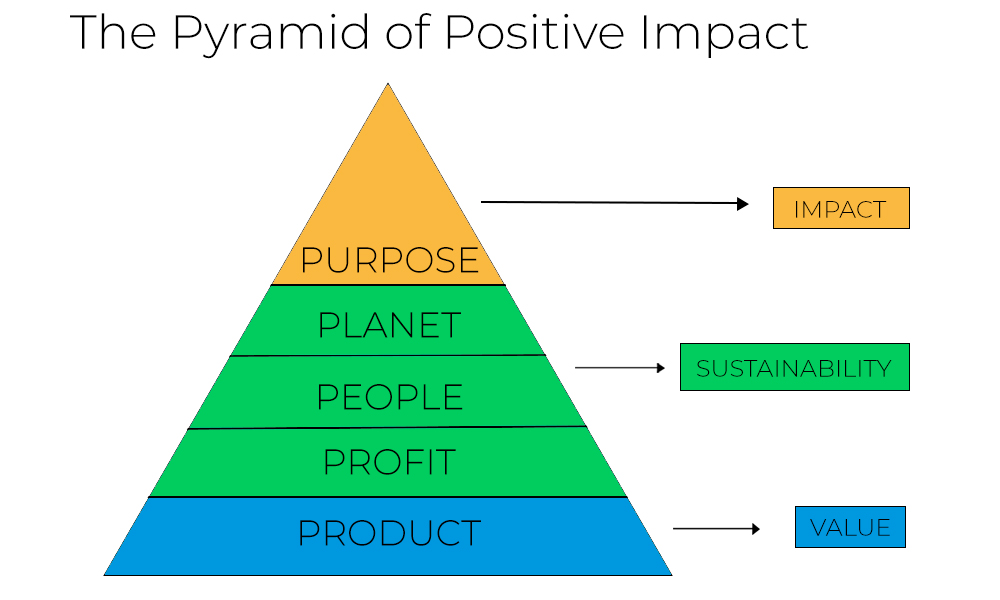Companies play a fundamental role in our society, not only because they are a source of employment that allow people to earn a living but also because their actions, products, and services are constantly changing the world.
When Apple introduced the first smartphone to the market, the world changed for the better, with millions of people able to access a device that offered them the opportunity to entertain themselves, communicate with one another, and boost their creativity. In much the same way, when Tesla began to promote its electric vehicles, the company generated a new market trend that forced the rest of the industry to prioritize planning in relation to the electric vehicle, thus accelerating the world’s transition to sustainable energy.
Yes, companies can make a positive impact on the world while making money. However, it is essential to understand that this positive impact is not valid if, at the same time, a company leaves a negative footprint. The end does not justify the means. For example, a company that pledges to democratize fashion but still doesn’t produce their products in an ethical way (so it’s not sustainable from a social point of view) is not, in the end, making a positive impact on the world. The leadership is simply assuaging a certain amount of guilt. Only those organizations that carry out their operations in a sustainable way – economically, socially, and environmentally – can claim to create a positive impact. Of course, for all this to be possible, especially for the company to be economically sustainable, having a good product or service is necessary, one that adds value to customers.
In fact, according to McKinsey, purpose-driven businesses with a long-term view of value creation generate 47% more revenue than traditional businesses. Also, 87% of executives believe that companies perform best over time if their purpose goes beyond profit.
There are different levels at which a company can operate that encourage an authentic positive impact on the world, while still making a profit. It is necessary to cover the lower levels first in order to reach those that are higher, as is the case of Maslow’s pyramid of human needs. This is what I call the Pyramid of Positive Impact (or the pyramid of the five P’s). The base level of organizations, the first P, is the product. This product, of course, must be of good quality that adds value to the market, because this gets the company to the next stage, profit, that allows for the company to be economically sustainable. At this point, the company must also become sustainable with society at large, people and planet. Then, finally, comes purpose, that internal element that serves as the guide for a company to make a positive impact on the world.
Created by Francisco Palao
The purpose is a key element for any organization (and also for people) that describes why they do what they do. Purpose should talk about a better version of the world, and not about the company itself. Along with purpose, we still keep the vision (what we want to be in the future) and the mission (how we will achieve our vision). Therefore, purpose, vision, and mission are the key elements that will define the identity of an organization.
More and more companies are beginning to define and communicate their purpose, that is, the reason why they exist and the positive impact they want to make on the world. Apple’s purpose is to ‘enhance people’s creativity’, Tesla’s purpose is ‘to accelerate the world’s transition to sustainable energy’, Patagonia’s is to ‘save the planet’; All of these organizations carry out their entire strategy, including all of their products and services, around their purposes. In order to do that, they launch different types of initiatives sharing the purpose among all of them.
In fact, even this phenomenon of purpose is expanding. Organizations are becoming (or connecting to) purpose-driven ecosystems that enable them to access opportunities in multiple markets and a variety of industries.
Purpose-driven companies have greater all-around potential than those only focused on economic results. After all, as Peter Diamandis likes to say, the world’s biggest problems are the world’s biggest market opportunities. This particularly applies to new businesses and startups, since those that start with a clear purpose have a better chance of surviving and achieving their goals.
For example, Apple is no longer a computer company but, keeping its purpose at the center has created a series of products and services belonging to different industries (computers, telephones, software applications, Artificial Intelligence assistants, etc.) that in one way or another serve their purpose.
Tesla is not just a vehicle company either but a purpose-driven ecosystem that has created a series of products and services (electric vehicles, batteries, solar panels, applications, etc.) around its own purpose. This is precisely the reason why Tesla has a market capitalization greater than that of the sum of its competitors. Tesla has risen to the top of the Positive Impact Pyramid, giving it access to an abundance of opportunities.
But how can companies recognize and take advantage of these kinds of opportunities? It is no longer a question of developing new technologies – nor is it even about innovation. The key is to evolve mindset. Leadership teams must learn to see the world and a company’s projects in a new and different way. However, this is hard and often pathless work.
But, make no mistake, the movement is here – amongst organizations and individuals alike – to make business something that changes the world for the better. We have entered the age of positive impact. Company case studies such as Apple, Tesla, Patagonia, and many others are clear indicators of this. What is needed now is the dedication of leadership teams focused on the intersection of changing the world for the better and economic viability.
Going back to the initial question of the title, the point is not whether companies can make money while improving the world, since we made it quite clear from the beginning that it is possible. What we all have to understand is that trying to make a positive impact on the world with our startups and established organizations can be the best strategy to also boost our business.
© IE Insights.












